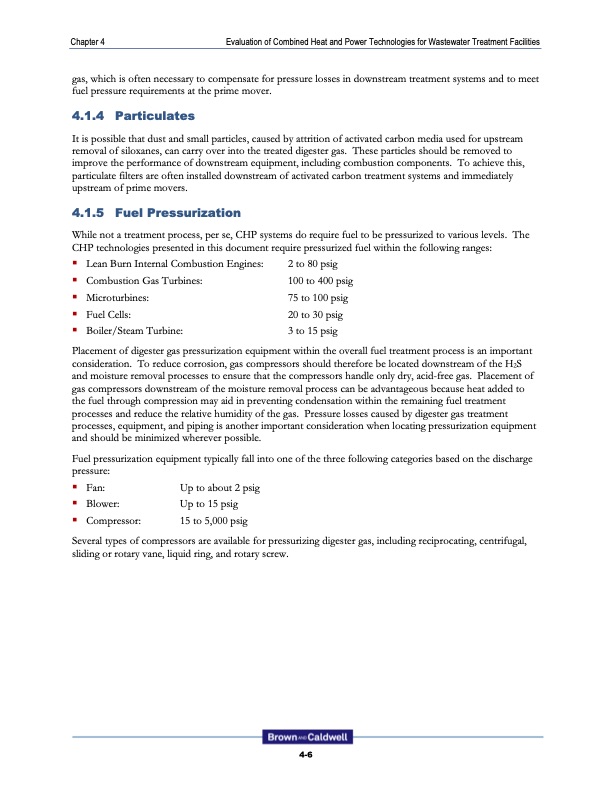
PDF Publication Title:
Text from PDF Page: 058
Chapter 4 Evaluation of Combined Heat and Power Technologies for Wastewater Treatment Facilities gas, which is often necessary to compensate for pressure losses in downstream treatment systems and to meet fuel pressure requirements at the prime mover. 4.1.4 Particulates It is possible that dust and small particles, caused by attrition of activated carbon media used for upstream removal of siloxanes, can carry over into the treated digester gas. These particles should be removed to improve the performance of downstream equipment, including combustion components. To achieve this, particulate filters are often installed downstream of activated carbon treatment systems and immediately upstream of prime movers. 4.1.5 Fuel Pressurization While not a treatment process, per se, CHP systems do require fuel to be pressurized to various levels. The CHP technologies presented in this document require pressurized fuel within the following ranges: Lean Burn Internal Combustion Engines: Combustion Gas Turbines: Microturbines: Fuel Cells: Boiler/Steam Turbine: 2 to 80 psig 100 to 400 psig 75 to 100 psig 20 to 30 psig 3 to 15 psig Placement of digester gas pressurization equipment within the overall fuel treatment process is an important consideration. To reduce corrosion, gas compressors should therefore be located downstream of the H2S and moisture removal processes to ensure that the compressors handle only dry, acid-free gas. Placement of gas compressors downstream of the moisture removal process can be advantageous because heat added to the fuel through compression may aid in preventing condensation within the remaining fuel treatment processes and reduce the relative humidity of the gas. Pressure losses caused by digester gas treatment processes, equipment, and piping is another important consideration when locating pressurization equipment and should be minimized wherever possible. Fuel pressurization equipment typically fall into one of the three following categories based on the discharge pressure: Fan: Blower: Compressor: Up to about 2 psig Up to 15 psig 15 to 5,000 psig Several types of compressors are available for pressurizing digester gas, including reciprocating, centrifugal, sliding or rotary vane, liquid ring, and rotary screw. 4-6PDF Image | Combined Heat and Power Technologies for Wastewater Facilities

PDF Search Title:
Combined Heat and Power Technologies for Wastewater FacilitiesOriginal File Name Searched:
300_CHP-EPA-w-Apps.pdfDIY PDF Search: Google It | Yahoo | Bing
Capstone Turbine and Microturbine: Capstone microturbines used and new surplus for sale listing More Info
Consulting and Strategy Services: Need help with Capstone Turbine, sizing systems, applications, or renewable energy strategy, we are here to assist More Info
Container Lumber Dry Kiln: Since 1991 developing and innovating dry kilns using standard shipping containers More Info
Supercritical CO2 Lumber Dry Kiln: Compact fast drying in 3 days or less for small amounts of wood and lumber drying More Info
BitCoin Mining: Bitcoin Mining and Cryptocurrency... More Info
Publications: Capstone Turbine publications for microturbine and distributed energy More Info
FileMaker Software for Renewable Energy Developing database software for the renewable energy industry More Info
CO2 Gas to Liquids On-Demand Production Cart Developing a supercritical CO2 to alcohol on-demand production system (via Nafion reverse fuel cell) More Info
Stranded Gas for low cost power Bitcoin Mining Using stranded gas for generators may provide breakthrough low power costs for cryptocurrency miners. More Info
| CONTACT TEL: 608-238-6001 Email: greg@globalmicroturbine.com | RSS | AMP |